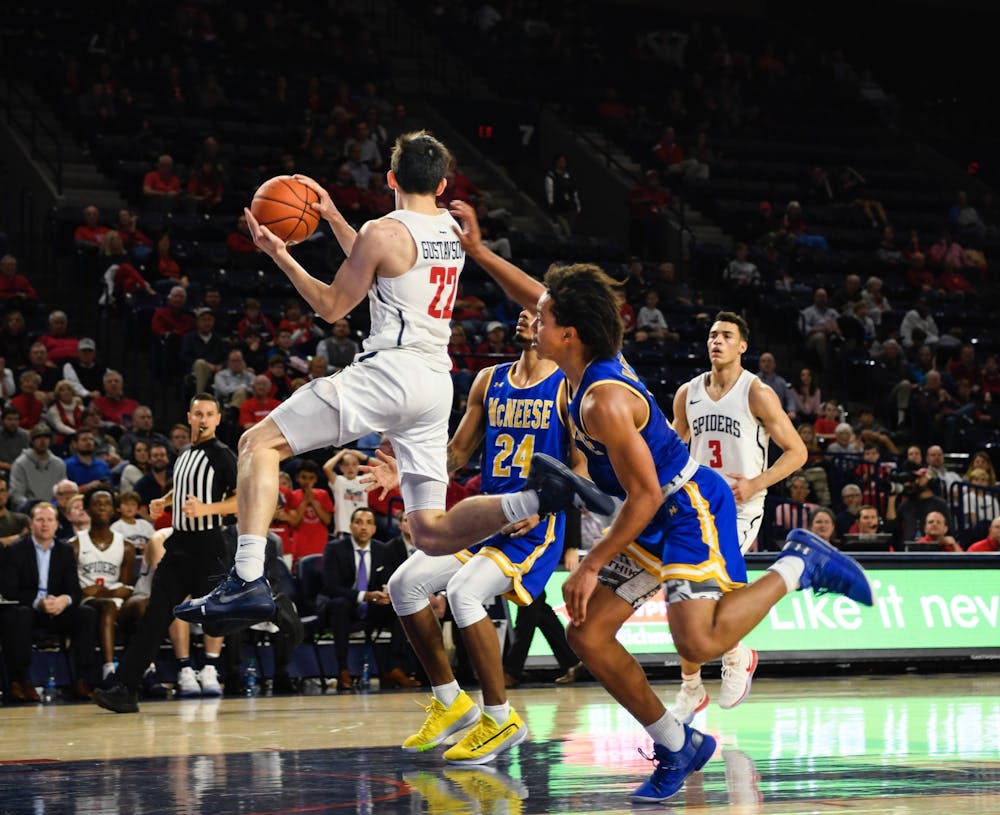Ever wonder what it’s like to be an international student? What about an international student-athlete? Andre Gustavson, a sophomore on the men’s basketball team, sought international education from Helsinki, Finland.
As a first-year, he played in 31 games and averaged 4.8 points and 2.3 rebounds.
And as the 2019-2020 season has gotten underway, Gustavson has helped the Spiders to a 7-1 start on the season thus far.
Gustavson attended the Helsinki Basketball Academy, which is part of Mäkelänrinne, a non-graded Finnish sports high school. Mäkelänrinne is one of only 13 high schools in Finland that offer sports directly affiliated with the school, according to Mäkelänrinne's website.
Mäkelänrinne’s school system is unconventional in comparison with the systems of U.S. high schools -- it offers students the flexibility of choosing their own study programs and schedules. Mäkelänrinne's website states that students determine the length of their high school experience.
This system proves to be successful, as Mäkelänrinne's website states that it sees high scores on the Matriculation Exam in accordance with high course grades received at Mäkelänrinne. A non-graded school system boasts students with more responsibility over their own coursework and stronger relationships between students and teachers, according to Mäkelänrinne.
Gustavson started looking into international education when he was a first-year at Mäkelänrinne.
“As a freshman, I started thinking about what I could do after graduating high school," Gustavson said. "I had a coach who played in the NBA.”
Hanno Möttölä, the first person from Finland to play in the NBA, was one of Gustavon’s coaches in high school, Gustavson said. Möttölä played at the University of Utah and went on to play for the Atlanta Hawks in the early 2000s before playing for different European teams for the remainder of his career, according to statistics from Basketball Real GM.
“He kind of just sat my mom and I down and talked us through the different options available to me, the rules, and he also helped me with getting connections in the United States,” Gustavson said.
There are a few differences between European basketball and American basketball. In Finland, the shot clock is set to 24 seconds, which makes the game faster-paced than it is with the 35-second shot clock used in the NCAA, Gustavson said. Both the NBA and the Fédération Internationale de Basketball, the organization that all 50 national European basketball federations are in, use a 24-second shot clock.
Gustavson also mentioned the contrast in team dynamics on the court.
Enjoy what you're reading?
Signup for our newsletter
“There’s always going to be that person who scores more, but I think here you see more of that here than at home,” Gustavson said.
Nevertheless, Spiders Head Coach Chris Mooney believed there were some similarities between the European style and UR's style of basketball, particularly with decision making and versatility. Mooney said that can be attributed to the U.S. being more position-designated.
“European-style basketball fits our style of basketball, and the players recognize that,” Mooney said.
Mooney also emphasized the importance of cultural diversity, for both the team and the university.
Gustavson first heard from UR around March 2018 when he was contacted by Rob Jones, associate head coach, who has now been working with the basketball program for the last 15 seasons.
“I could have visited three schools but Coach Jones took a strong interest in me," Gustavson said. “I felt like this [UR] was the right fit, so I didn’t feel like I needed to visit other schools."
Mooney puts an emphasis on establishing relationships with the parents of international student-athletes.
“European parents want to see the campus and meet the people that will be supporting their son," Mooney said. "It’s a big decision for them.”
The opportunities after high school are much different in Europe than in the United States, Gustavson said. He said that European colleges did not have varsity sports. Instead, athletes with potential will typically either go to the U.S. to play or play professionally in their respective countries.
Gustavson did not really consider playing professionally in Finland because athletes need agents, he said. It is against NCAA rules to have an active agent while pursuing collegiate sports in the United States, according to NCAA's regulations.
But, that is not to say the opportunity never arose for Gustavson, if he had wanted it.
“I had a few coaches from Finland contact me asking to play with them if I didn't go to the U.S.,” Gustavson said.
The basketball team stays on campus for a portion of the summer to train before going home for a break. Gustavson’s situation is quite different from his teammates', as he did not stay on campus to train but returned to Finland after second-semester finals to compete in the 2019 University World Games, a tournament for athletes who attend universities, Gustavson said.
Gustavson also played on national teams during his high school career.
“I represented Finland, along with other athletes who have played on Finland’s national team, before going to college," Gustavson said. "When I was talking to U.S. schools, the [Finland] national team coach asked if I could spend the summers with the national team because it’s important to them."
The men's basketball team rosters a few other international players as well, including redshirt sophomore Tomas Verbinskis from Klaipeda, Lithuania, junior Nathan Cayo from Montreal, Quebec, and sophomore Matt Grace from Hamilton, Ontario.
Contact sports writer Grace Mittl at grace.mittl@richmond.edu
Support independent student media
You can make a tax-deductible donation by clicking the button below, which takes you to our secure PayPal account. The page is set up to receive contributions in whatever amount you designate. We look forward to using the money we raise to further our mission of providing honest and accurate information to students, faculty, staff, alumni and others in the general public.
Donate Now



